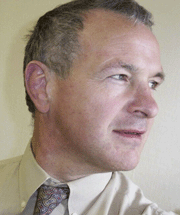E-Archive
Standards Forum
in Vol. 11 - September Issue - Year 2010
AMS 2580, Ultrasonically Activated Peening

Paul Huyton
It has been released and is now available for general use. This Aerospace Material Specification (AMS) is published by the SAE and is available for purchase from their website, www.sae.org.
Ultrasonic peening, as it is generally termed, has become an established technology with many applications in aerospace and other industry sectors. Until now the process has been defined by parameters established between the user and equipment supplier. Approvals to use the process have been issued by aero engine and airframe manufacturers, diesel engine companies, also nuclear and conventional power generation equipment organizations. The process is favourable for particular applications because the surface roughness is very low, there is no loose shot to become trapped in component cavities, noise levels are relatively low and there is a high degree of process repeatability.
The new AMS was published 17 May 2010 and provides all the key requirements needed for the successful application of this technology. Applications may still require development work between the equipment manufacturers but the AMS is a benchmark to ensure that any application conforms to the agreed standard. The requirements of the AMS also can be used as auditable criteria to assist with the regulation of the process.
Also published on the same date was AMS 2585, Shot Peening Media, Ultrasonically Activated. This AMS is complimentary to the processing AMS 2580 and gives the requirements for the media or shot, to be used in the ultrasonically activated process. With all shot peening, media specification and quality are key to obtaining the maximum benefit from the process. With ultrasonically activated peening it is vital to have the correct media by the particle size, composition and total mass of media. The superior surface finish obtained with ultrasonically activated peening is largely due to the very high quality of media that is used. This is possible because only a small quantity of media is required so it is cost-effective to use perfectly spherical shot without mis-shapes.
The establishment of AMS 2580 and AMS 2585 is an important step in progressing the use of this important technology over a wider range of applications. It will also assist in the reliability of existing applications as the key process variables are defined and other process quality issues addressed.
A new AMS standard for Ultrasonic Needle Peening is also now in development. This technology is largely used for peen forming and straightening. The large mass of the "needles" which impact the surface can achieve very high intensities with an acceptable resultant surface roughness measurement. This means that thick material sections, previously beyond the capability of shot peen forming, can be formed or straightened.
These AMS specifications are products of the Surface Enhancement sub-committee of the Aerospace Engineering Committee, reporting to the SAE. The committees are made up of established engineers who volunteer their time to improve and establish standards in the industry. The Surface Enhancement sub-committee has also just completed a profound review of AMS 2430, Shot Peening, Automatic. This review clarifies the technical requirements for processing and differentiates these from guidance in design and specifying of shot peening. It also includes comprehensive requirements and guidance for the tests needed to achieve previously stated shot quality requirements. These are normally recognized as the sieve analysis to provide limits on used shot particle size and the visual inspection, with magnification, to identify the content of unacceptable shot shapes. Previous revisions included requirements for the shot quality results but without the requirements on the test procedures. The new revision will provide an appropriate degree of standardization for test procedures to ensure consistency and comparability of test results between users. Importantly, the revision also accommodates the requirements of AMS-13165 (formerly MIL-S-13165), which is now cancelled. It therefore facilitates the shot peening of legacy parts, on which MIL-S-13165 was specified, using the AMS 2430 specification. Although the Surface Enhancement sub-committee has completed the task, the revised AMS is subject to rigorous technical and editorial scrutiny by two further committees before publication can be approved. However it is hoped that the new revision of AMS 2430 will be published before the end of this year.
For questions contact paul@mfn.li
Standards Forum
by Paul Huyton,
MFN Course Director World Wide
more information at www.mfn.li/trainers



























